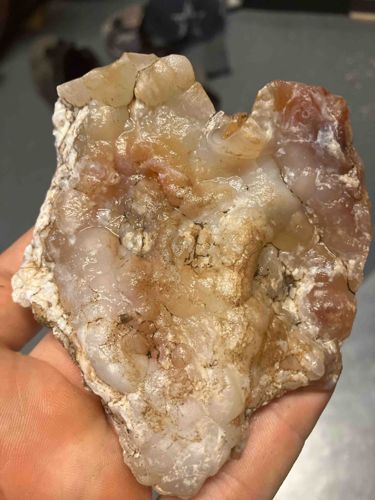
Botryoidal Agate Specimen
The item is a raw, unpolished specimen of botryoidal agate, potentially carnelian agate or fire agate based on the coloring. It has an irregular, organic shape with a botryoidal (grape-like) or mammillary surface texture on one side, characteristic of this form of mineral growth. The colors range from opaque white to translucent and semi-translucent shades of light pink, peach, orange, and reddish-brown. There are visible veins and inclusions throughout the specimen. Some areas appear more crystalline with a rough fracture, while others exhibit the smoother, rounded botryoidal formations. The back or base of the specimen appears to be a rough, likely part of the host rock matrix or a fractured surface. There are no discernible maker's marks, signatures, or stamps. The condition appears natural and unaltered, with no visible signs of polishing, cutting, or artificial treatment. There is some minor adherence of what appears to be dirt or fine debris in crevices. The specimen's size is consistent with being held in a single hand, suggesting a moderate size for a raw mineral sample. The quality appears good for a natural, unworked specimen, showcasing distinct botryoidal formations and varied coloration. The estimated age is geological.
AI-Generated Appraisal Disclaimer
Estimated Value
$40-60
Basic Information
Category
Mineral Specimen
Appraised On
December 14, 2025
Estimated Value
$40-60
Item Description
The item is a raw, unpolished specimen of botryoidal agate, potentially carnelian agate or fire agate based on the coloring. It has an irregular, organic shape with a botryoidal (grape-like) or mammillary surface texture on one side, characteristic of this form of mineral growth. The colors range from opaque white to translucent and semi-translucent shades of light pink, peach, orange, and reddish-brown. There are visible veins and inclusions throughout the specimen. Some areas appear more crystalline with a rough fracture, while others exhibit the smoother, rounded botryoidal formations. The back or base of the specimen appears to be a rough, likely part of the host rock matrix or a fractured surface. There are no discernible maker's marks, signatures, or stamps. The condition appears natural and unaltered, with no visible signs of polishing, cutting, or artificial treatment. There is some minor adherence of what appears to be dirt or fine debris in crevices. The specimen's size is consistent with being held in a single hand, suggesting a moderate size for a raw mineral sample. The quality appears good for a natural, unworked specimen, showcasing distinct botryoidal formations and varied coloration. The estimated age is geological.
Related Tags
Get Your Items Appraised
Instant estimates of your treasures with AI-powered instant appraisals